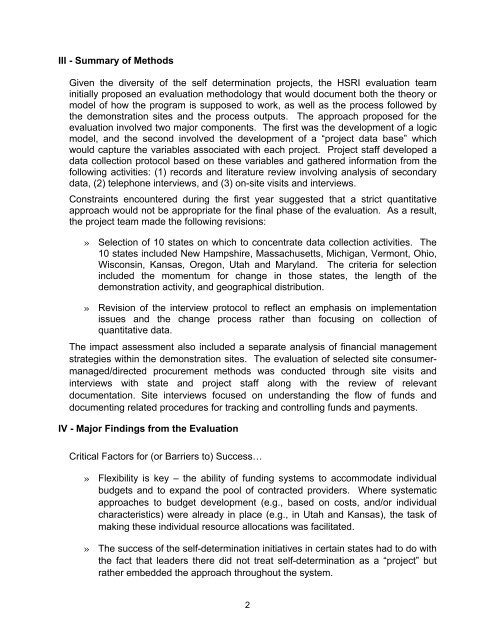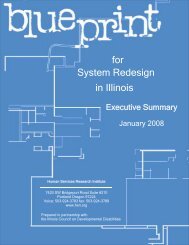RWJF Evaluation Report Abstract Impact Assessment of the Self ...
RWJF Evaluation Report Abstract Impact Assessment of the Self ...
RWJF Evaluation Report Abstract Impact Assessment of the Self ...
Create successful ePaper yourself
Turn your PDF publications into a flip-book with our unique Google optimized e-Paper software.
III - Summary <strong>of</strong> Methods<br />
Given <strong>the</strong> diversity <strong>of</strong> <strong>the</strong> self determination projects, <strong>the</strong> HSRI evaluation team<br />
initially proposed an evaluation methodology that would document both <strong>the</strong> <strong>the</strong>ory or<br />
model <strong>of</strong> how <strong>the</strong> program is supposed to work, as well as <strong>the</strong> process followed by<br />
<strong>the</strong> demonstration sites and <strong>the</strong> process outputs. The approach proposed for <strong>the</strong><br />
evaluation involved two major components. The first was <strong>the</strong> development <strong>of</strong> a logic<br />
model, and <strong>the</strong> second involved <strong>the</strong> development <strong>of</strong> a “project data base” which<br />
would capture <strong>the</strong> variables associated with each project. Project staff developed a<br />
data collection protocol based on <strong>the</strong>se variables and ga<strong>the</strong>red information from <strong>the</strong><br />
following activities: (1) records and literature review involving analysis <strong>of</strong> secondary<br />
data, (2) telephone interviews, and (3) on-site visits and interviews.<br />
Constraints encountered during <strong>the</strong> first year suggested that a strict quantitative<br />
approach would not be appropriate for <strong>the</strong> final phase <strong>of</strong> <strong>the</strong> evaluation. As a result,<br />
<strong>the</strong> project team made <strong>the</strong> following revisions:<br />
» Selection <strong>of</strong> 10 states on which to concentrate data collection activities. The<br />
10 states included New Hampshire, Massachusetts, Michigan, Vermont, Ohio,<br />
Wisconsin, Kansas, Oregon, Utah and Maryland. The criteria for selection<br />
included <strong>the</strong> momentum for change in those states, <strong>the</strong> length <strong>of</strong> <strong>the</strong><br />
demonstration activity, and geographical distribution.<br />
» Revision <strong>of</strong> <strong>the</strong> interview protocol to reflect an emphasis on implementation<br />
issues and <strong>the</strong> change process ra<strong>the</strong>r than focusing on collection <strong>of</strong><br />
quantitative data.<br />
The impact assessment also included a separate analysis <strong>of</strong> financial management<br />
strategies within <strong>the</strong> demonstration sites. The evaluation <strong>of</strong> selected site consumermanaged/directed<br />
procurement methods was conducted through site visits and<br />
interviews with state and project staff along with <strong>the</strong> review <strong>of</strong> relevant<br />
documentation. Site interviews focused on understanding <strong>the</strong> flow <strong>of</strong> funds and<br />
documenting related procedures for tracking and controlling funds and payments.<br />
IV - Major Findings from <strong>the</strong> <strong>Evaluation</strong><br />
Critical Factors for (or Barriers to) Success…<br />
» Flexibility is key – <strong>the</strong> ability <strong>of</strong> funding systems to accommodate individual<br />
budgets and to expand <strong>the</strong> pool <strong>of</strong> contracted providers. Where systematic<br />
approaches to budget development (e.g., based on costs, and/or individual<br />
characteristics) were already in place (e.g., in Utah and Kansas), <strong>the</strong> task <strong>of</strong><br />
making <strong>the</strong>se individual resource allocations was facilitated.<br />
» The success <strong>of</strong> <strong>the</strong> self-determination initiatives in certain states had to do with<br />
<strong>the</strong> fact that leaders <strong>the</strong>re did not treat self-determination as a “project” but<br />
ra<strong>the</strong>r embedded <strong>the</strong> approach throughout <strong>the</strong> system.<br />
2






